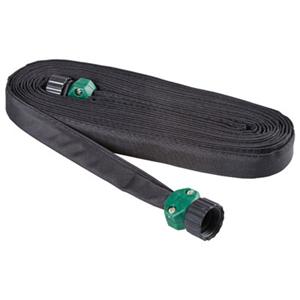Inside a greenhouse, it’s fairly easy to control the water your plants get. Out under the open sky, it’s harder.
Normally, by July, I would be starting to tire of the watering routine; the hoses seem to get heavier with every summer day that passes. This year, since the Chicago area got almost 8 inches of rain in June, it hasn’t been much of an issue. In fact, I only watered once in June and within 24 hours after that it rained 3 inches. That’s the gardener’s rain dance.
Still, I realize that there are parts of the country that aren’t being flooded out. And who knows? We might not see more rain for months. So I thought I’d mention some doodads that make watering easier for me when it’s hot and dry.
Soaker hoses. There’s no simpler, more flexible way to deliver only the water you need, only where your plants need it (at the roots). The water oozes out slowly all along the hose and soaks right into the soil, so not much is wasted by evaporation. And unlike a sprinkler, soaker hoses don’t get the plants’ leaves wet, which can invite diseases. Once it soaks in, the water will spread through the soil a foot or more on either side of the hose.
I have two kinds of soaker hoses, the round porous rubber ones and the lightweight flat fabric ones. The rubber ones work fine if I remember to lay them out early in the season, before the perennials sprout. But if I forget, the more flexible fabric hoses can be carefully snaked between full-grown plants. I never connect more than two 50-foot lengths of soaker hose, because the water pressure drops off with distance.
I have tried drip irrigation, but I found it too complex, too fiddly, and too hard to change as my garden mutates. I think drip irrigation works better for row-crop farmers or for large-scale greenhouse crops than for most home gardeners, who are better off with soaker hoses.
Quick connectors. These let me quickly and easily swap out nozzles, sprinklers and hoses. I have found that it’s worthwhile to pay for solid brass ones and I stick with a single widely available brand (Nelson) so I can be sure any connector I buy will fit the ones I have. All my soaker hoses have quick connectors so I can easily switch the water hose from one zone to another. Tip: If a connection dribbles, check that both the quick connectors are screwed in tight.
A timer. For me, this is the killer app of watering. A simple mechanical hose timer, which turns off the water after the period I set it for, costs $10 or $15. I can set up a sprinkler or soaker hose and go run errands or take a nap. I can turn on the water on my way to work and know it will shut off when I planned. And here’s my favorite: I can set the timer on a soaker hose and go off to bed. Gardeners usually are advised not to water in the evening with a sprinkler, because the plants’ foliage won’t dry off. But with a soaker hose that doesn’t get the leaves wet, there’s no problem. With the combination of soaker hose and timer, I can water when demand for water is lowest and there’s the least loss to evaporation.
Rain gauge. A simple plastic tube with inch markings, positioned where I can see it from indoors, tells me how much it really rained (a whole lot of thunder and lightning can produce surprisingly little actual precipitation sometimes). It’s actually a good idea to have two or three rain gauges scattered around, since trees, fences, roof overhangs and other factors can affect how much rain actually reaches the ground; I get much more rain in some parts of my garden than others. Remember to empty rain gauges often or they’ll be a place for mosquitoes to breed.
Mulch. If I’ve gone to the trouble to put water into the soil, I want to keep it there. Mulch insulates the soil against the hot sun and deters evaporation. You don’t need much: 1 to 2 inches of relatively fine mulch spread in perennial and vegetable beds (I use shredded leaves) and 3 to 4 inches of chunkier mulch, such as wood chips, in a wide circle around trees and shrubs. Spread mulch in an even layer and don’t pile it up against a tree trunk, or it can cause the bark to rot.


